How to Use Adjustable Dumbbells to Elevate Your Workout
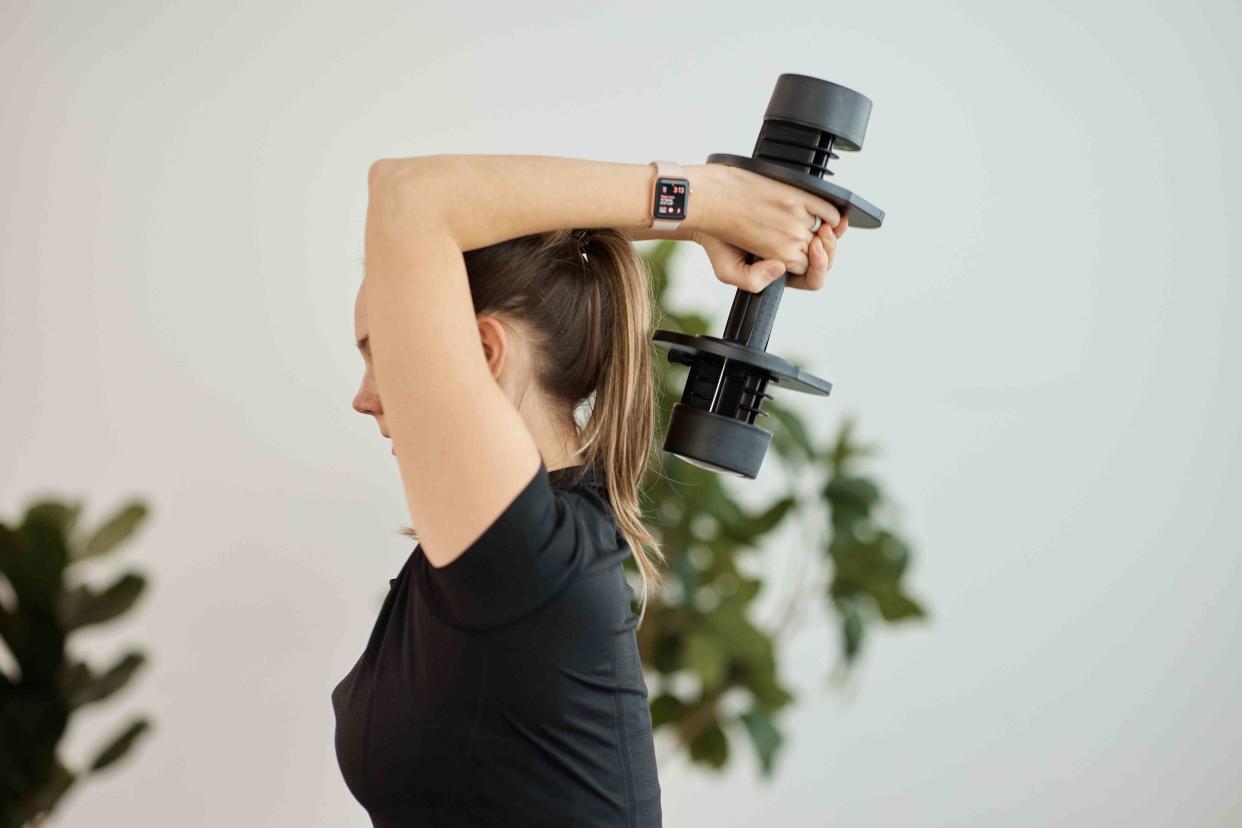
Verywell / Nick Kova
Home workouts offer convenience, flexibility, and privacy, making it more tempting to trade the gym for your living room. However, when transitioning to working out from home, it becomes increasingly apparent that the local athletic club does have a few perks—namely, workout equipment. Bodyweight workouts can be fantastic, but strength-building tools can help take your training to the next level.
Thankfully, exercise innovators have developed a practical and pretty effective solution to increasing muscle mass for health – the adjustable dumbbell. So if outfitting your living area with a plethora of equipment is out of the question, these compact handheld devices may solve your space woes. The best part is they're versatile, meaning you won't need to swap out workout tools any time soon.
Here's how adjustable dumbbells work and how to add them to your home workout routine.
How Adjustable Dumbbells Work
You're likely familiar with traditional dumbbells, composed of a weight on either end of a bar made to grip. Adjustable dumbbells have a similar profile but are significantly different. Instead of having a rack of dumbbells, each with a set weight, adjustable dumbbells offer various weights in one handheld device.
Thanks to a mechanism at the end of the grip bar, like a pin or dial, you can choose how heavy the dumbbell will be, effortlessly swapping between weighted discs or plates for different movements and fitness capabilities. Adjustable dumbbells can accommodate your needs, from beginner to advanced, transitioning from 10 pounds to nearly 100 pounds in a single set.
You can choose adjustable dumbbells that build anywhere from 50 pounds to about 200 pounds. However, most home workout aficionados do well with the 50-pound range. To offer versatility in weight, adjustable dumbbells use plates or discs in 10-pound increments.
A mechanism can add (or remove weighted plates) to adjust the overall mass of the dumbbell. While you will get faster with practice, adjustable dumbbell transitions have a slight learning curve.
“Adjustable dumbbells that load up from the end with plates and a lock nut are going to work and feel no different from what you're used to,” says certified personal trainer Mike Silverman. Still, some select styles may have a slightly different feel in your hand, thanks to “differences in the amount of handle space and grip options,” continues Silverman. Nevertheless, like traditional models, adjustable dumbbells that load and bear weight should function and feel like your favorite gym set.
Types of Adjustable Dumbbells
There are many different types of adjustable dumbbells. The easiest types load and unload weight using a dial, a twist and lock handle, a pull-slide pin, or digital buttons. As you operate the mechanism while the dumbbell is in its unique base, weight is added or removed.
Any unused weights are left in the dock when you remove your dumbbell. A spinlock adjustable dumbbell is the "old-school" style of the adjustable dumbbell in which standard weight plates must be removed or added to a bar manually. The weight plates are secured on the bar with a collar, known as a spinlock.
Spinlock adjustable dumbbells are usually more affordable but can be cumbersome, making them unideal for fast-paced workouts. Alternatively, smart dumbbells featuring digital buttons are quick and easy, though they can command a hefty price.
How to Choose Adjustable Dumbbells for Your Needs
Ultimately, it comes down to your workout style, budget, and preferences when choosing adjustable dumbbells. When you've found the perfect set, thoroughly read the instructions and safety considerations before testing your dumbbells.
When to Increase Your Dumbbell Weight
As a rule of thumb, you should increase your dumbbell weight using the smallest increments possible. Additionally, if you feel you can't complete two more reps than your target rep range for two consecutive workouts, it's best not to increase your weight.
For example, if the workout calls for 10 reps of shoulder presses with five-pound weights and you can't complete 12 reps during two consecutive workouts, adjusting your dumbbell to a heavier setting is likely unsafe. Known as the "2 for 2" rule, this can be a helpful baseline for understanding when it is safe to raise your dumbbell weight.
Related:6 Benefits of Adjustable Dumbbells
Benefits of Adding Adjustable Dumbbells to Your Workout
We've established that adjustable dumbbells are space-saving and efficient, but are they effective? For most individuals, training with weights can help build muscle. Increasing strength and muscle mass is an integral part of a fitness routine.
Unlike resistance machines, free weights like dumbbells can increase free testosterone production, a hormone important in helping muscles like the heart contract more efficiently.
One study found that resistance training is excellent for skeletal muscle hypertrophy, meaning that your muscle cells increase and grow. Doing so increases your physical strength and may provide other health benefits.
For example, in a study on muscle-strengthening, researchers reported that it could lower your risk and mortality by almost 20% in significant non-communicable diseases, such as cardiovascular disease.
Other advantages include better intramuscular coordination, increased metabolism, improved mental health, and the ability to decrease body pain.
Whether you're looking to build strength and tone or improve your quality of life, resistance training with adjustable dumbbells can help you achieve your goals.
Related:The 7 Best Adjustable Dumbbells of 2023, Tested and Reviewed
Sample Workout with Adjustable Dumbbells
Adjustable dumbbells can be particularly convenient for full-body workouts, allowing you to increase and decrease weight as necessary to work major muscle groups. Silverman particularly enjoys movements like the bent-over row that a beginner “can’t go wrong with.”
Aim for ten reps of the following exercises. Repeat the workout two to three times.
Romanian Deadlifts
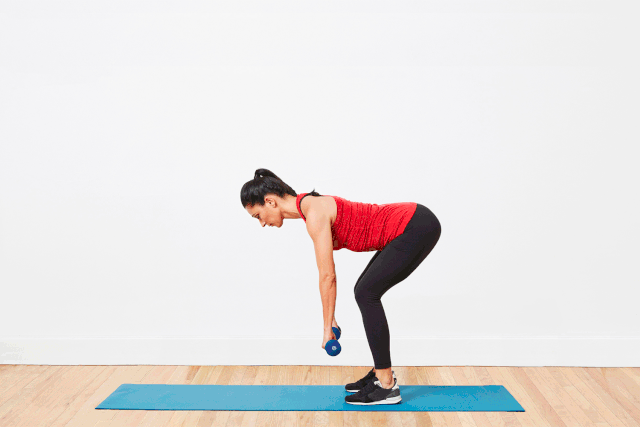
Verywell / Ben Goldstein
You’ll need two dumbbells for the Romanian Deadlift, a deadlift squat combination move.
With a dumbbell in each hand, stand with your feet hip-width apart. Your knees should be slightly bent.
Breaking at the hips, lean forward, keeping a neutral spine. Next, move the dumbbells in front of you, letting them hang shoulder-width apart but keeping a strong core and back.
Once you reach your knees, stop bending at the hips and squat until your dumbbells touch the floor.
Finally, engage your glutes and hamstrings to return to standing with your dumbbells at your sides.
Triceps Extension
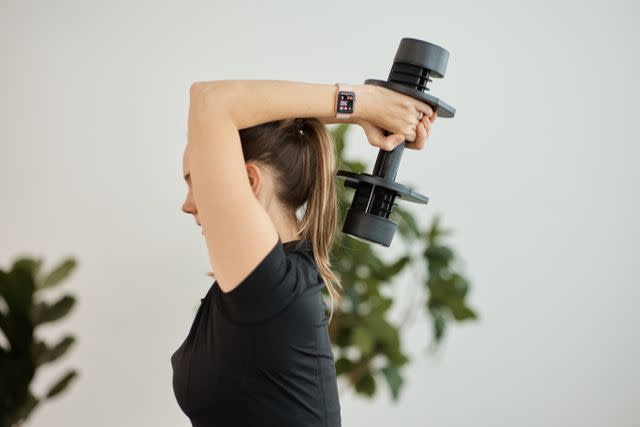
Verywell / Nick Kova
Only one dumbbell is required; you’ll generally want to start with a lighter weight.
Grasp one dumbbell cupped around the bar, under one weight plate, as if your hands form a collar with your palms facing upward.
Stand straight up, feet hip-width apart, with your core engaged, and your knees soft, not locked.
Raise the dumbbell overhead, positioning it so that when you lower it, it falls just behind you.
Extend both arms, raising the dumbbell fully, then slowly lowering it, gently bringing it down behind your head as you bend at the elbows.
Once you reach 90 degrees at the elbow, slowly raise the dumbbell back to the starting position overhead.
Keep your spine neutral, your core engaged, and your head aligned over your chest throughout the movement.
Related:How to Do a Triceps Extension: Proper Form, Variations, and Common Mistakes
Goblet Squat
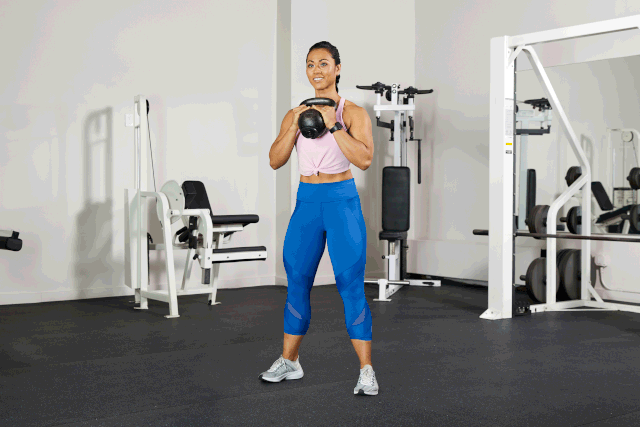
Verywell / Ben Goldstein
You’ll only need one heavier dumbbell.
Stand with your feet hip-width apart, grasping one end of the dumbbell in both hands so that your palms face each other and the weight is vertical.
Raise the dumbbell to your chest, holding it close to your body as you engage your core. Check that your toes point straight ahead, and squeeze your shoulder blades together.
Break at the hips first, sit your butt back, and bend at the knees to squat down. Keep the dumbbell close to your chest without rounding your back or shoulders.
Once your hips are even with your knees, or sooner if your back begins to round, push through your feet to return to standing, squeezing your glutes as you rise.
Related:How to Do a Goblet Squat
Bent-Over Row
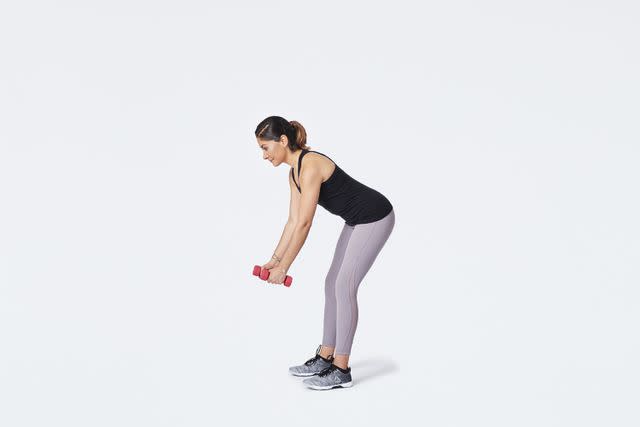
Verywell / Ben Goldstein
You’ll need two dumbbells of moderate weight.
Hold a dumbbell in each hand, grasping the bar with your palms facing each other.
Keeping your feet hip-width apart and your core engaged, bend over until you are at a 45-degree angle.
Draw your shoulder blades together with a neutral back, pulling the dumbbells upward towards your ribs.
Once you have exhausted your range of motion, slowly lower the dumbbells to the starting position.
Related:How to Do a Bent-Over Dumbbell Row: Proper Form, Variations, and Common Mistakes
Farmer's Carry
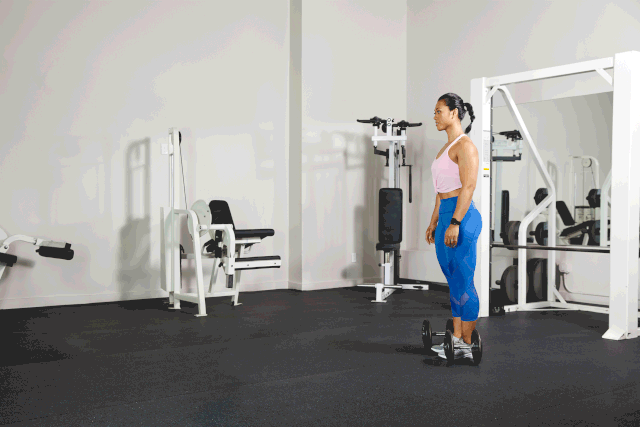
Verywell / Ben Goldstein
You’ll need two heavier dumbbells and an area where you can take at least five steps to perform the farmer’s carry.
Place one dumbbell on either side of your feet.
Squat down and grab a weight in each hand.
Return to standing while holding the weights with a strong core and engaged back.
Slowly walk forward, keeping a straight spine, strong back, and engaged core.
After your desired distance, squat down to place the weights on the floor.
Related:How to Do a Farmer's Carry: Proper Form, Variations, and Common Mistakes
Bicep Curl
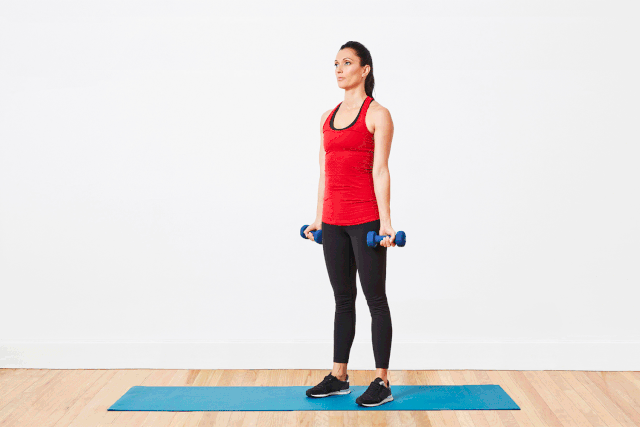
Verywell / Ben Goldstein
Two dumbbells of medium weight are needed.
Begin by holding a weight in each hand, grasped around the bar, letting them hang at your sides with your palms facing forward.
Your feet should be hip-width apart, your core drawn in.
Keeping your upper arms firmly against your sides, bend at the elbows to raise the dumbbells.
Once the dumbbells are close to your shoulders, exhausting your range of motion without your elbows flaring out, pause and contract your biceps.
Slowly lower your arms, keeping the movement controlled, to return to the starting position.
Related:How to Do Biceps Curls: Proper Form, Variations, and Common Mistakes
Frequently Asked Questions
Is it OK to work out with dumbbells every day?
Balance is key with exercise. Working out with dumbbells two to three times a week can produce health benefits. The Office of Disease Prevention and Health advises that adults should engage in muscle-strengthening activities two or more days a week. Overdoing it with exercise of any kind, including dumbbells, may lead to injury.
Are adjustable dumbbells easy to break?
Adjustable dumbbells are durable but not indestructible. Most sets that use small mechanisms like pins or dials and those that rely on digital devices do not tolerate being dropped. However, Silverman advises breaks are “pretty uncommon with high-quality gear,” and notes that “caring for your gear and buying higher quality stuff to begin with solves most problems.”

